Aikido Association of America home page. AAA's dojos are listed here; I hope you can find one near you.If not, AikiWeb maintains a wider directory of aikido schools, or simply Google "aikido <name of your city>."
Superb content at Aikido Journal. And great stuff (including my own posts) at the Aikido at the Leading Edge Facebook group.
The Conscious Manager's Reader Dialog Page includes questions and answers about aikido practice.
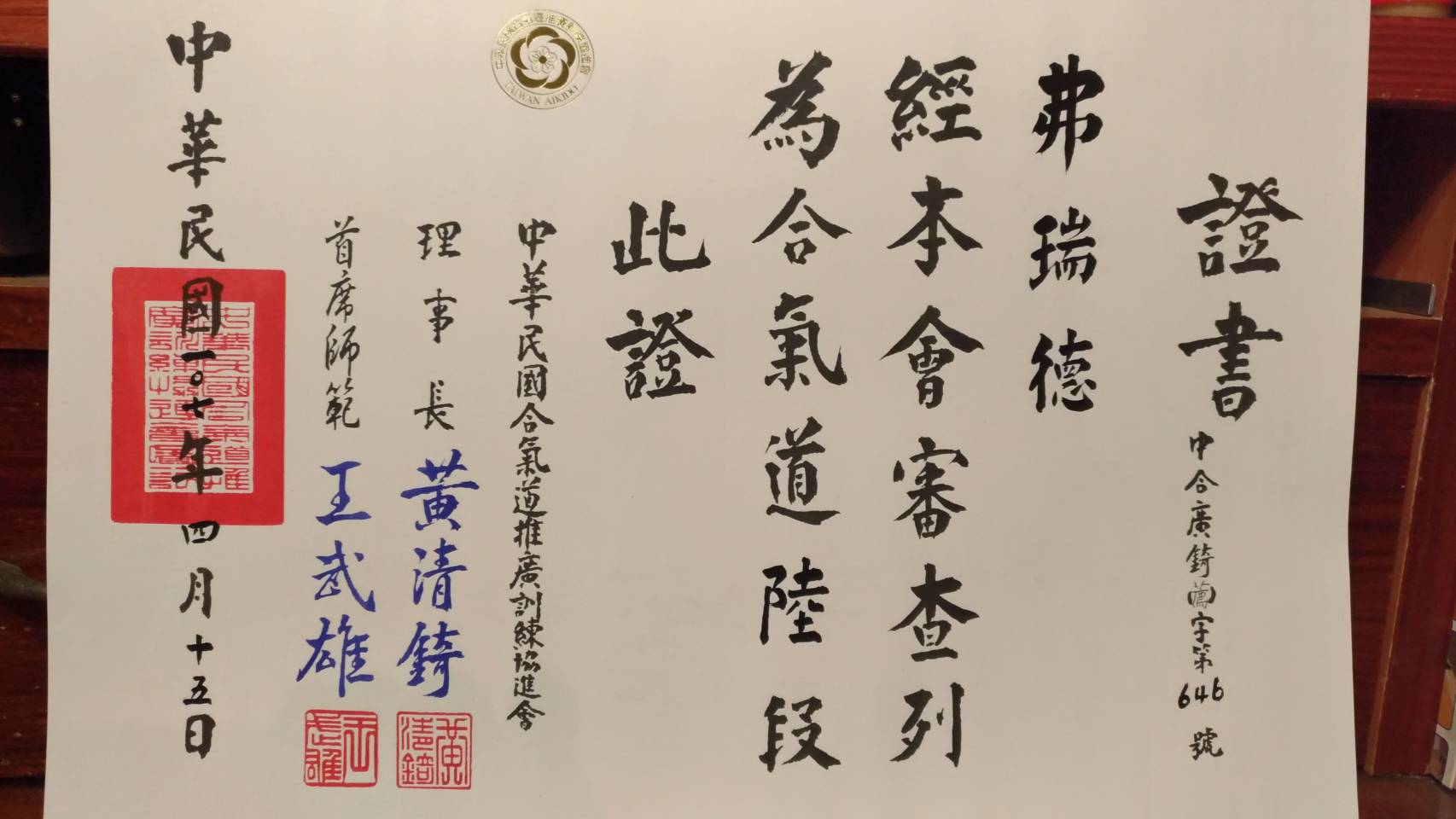
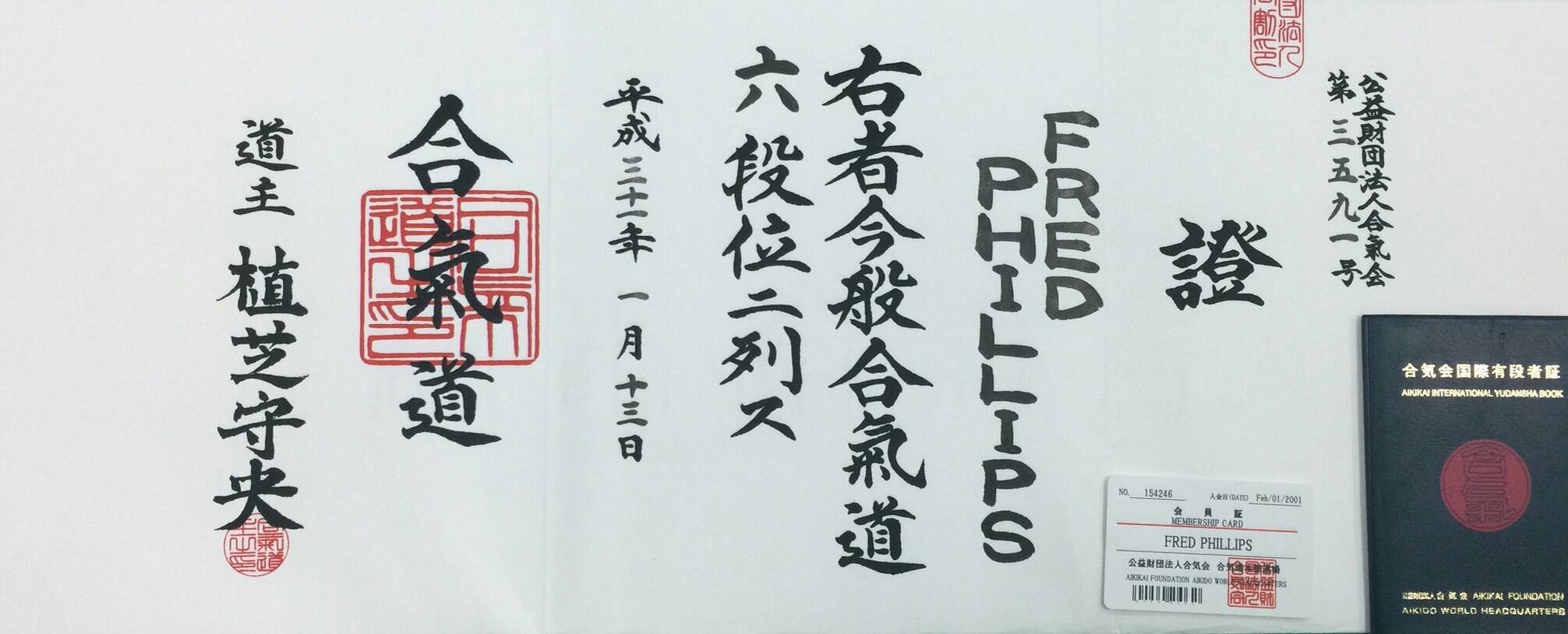
Fred Phillips, 6th Dan,
began his aikido training in early 1973. After breaking
too many bones (his own, not other people’s) during his year on
the 1972 University of Texas judo team, Fred wandered into Bill
Lee and Jay Portnow’s aikido practice. (Bill and Jay were,
respectively, students of Rod Kobayashi and Mitsunari Kanai.)
After one class, Fred knew he would practice aikido the rest of
his life.
When Fred won a
graduate fellowship for research in Japan, he trained under
Koichi Tohei Sensei at Ki Society HQ in Tokyo in 1975-76.
In 1977, Kobayashi Sensei awarded Fred shodan, and recommended
that he study with Fumio
Toyoda Shihan in Chicago.
In the next decades,
Fred ran dojos in Texas and Oregon under Toyoda Sensei’s
supervision. Shortly before he passed away in 2001, Toyoda
Sensei advanced Fred to 5th Dan, re-aligned Aikido Association
of America with World Aikikai
Honbu, and registered his students’ ranks with World
Aikikai Honbu.
In 2004, Fred moved to
Europe and enjoyed the hospitality of Aikido Tendo in Maastricht (the
Netherlands). His European job took him to Peru, Malta,
Cyprus, Belgium, Egypt, and Vietnam. In every country, he
practiced with, or was invited to teach at, local aikido
schools.
Between foreign
postings, Fred lived in San Diego, California, training
occasionally at the dojos of old friends Martin Katz and Ken MacBeth and
trying to learn Argentine tango at El Mundo del Tango.
From 2012 to 2015, Fred
worked in Korea, training and teaching with the World Aikikai
Honbu-affiliated Korean Aikido
Federation. In 2015 he was appointed Distinguished
Professor of Management at Yuan
Ze University in Taiwan, where he practiced and coached at
Dong Wu Dojo and at the National Chengchi University and
National Taiwan Normal University Aikido Clubs. He continues to
travel as guest and guest instructor at dojos worldwide.
 Toyoda Shihan
Toyoda ShihanThis photo of Morihei Ueshiba O-Sensei, or one like it, appears
in every aikido school. He is the revered founder of aikido.
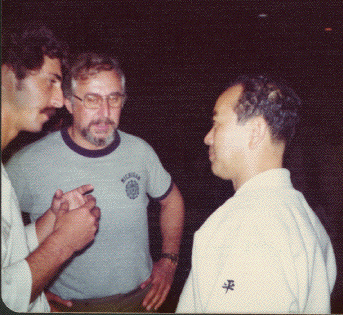
Koichi Tohei Sensei kindly responds to earnest questions from my
father and me, in Chicago, 1975. I later studied under
Tohei Sensei in Tokyo. Back to top.
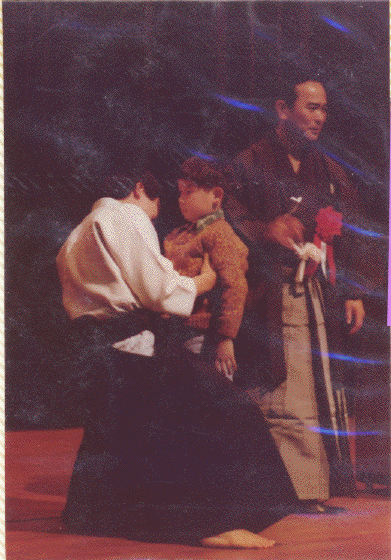
Tohei Sensei at a public demonstration in Shinjuku, Japan,
New Year 1976. He is showing that it is easy to teach a child to
exercise the power of ki. (Photo by author.)

Senseis Bill Lee and Jon Takagi in front of my parents' house in
Illinois, 1975. Back to top.
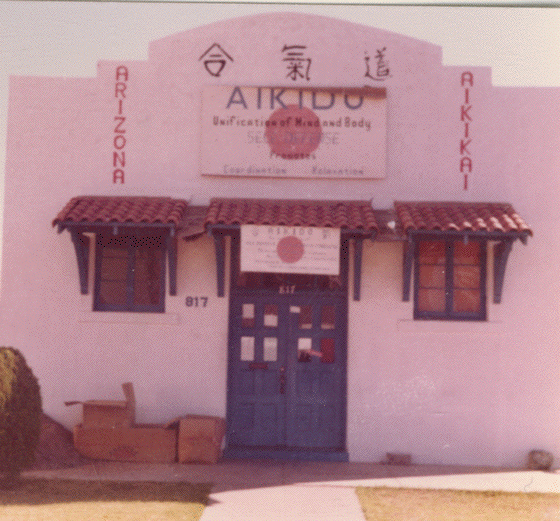
The late Jon Takagi's little adobe dojo in downtown Phoenix. (Photo by the author.)

Rod Kobayashi Sensei, Armando Flores and Wynn Lee at the
University of Texas. Austin, probably 1976. (Photo
by the author.)
Hawai'i-born Roderick Kobayashi went to Japan for his education
and was not able to leave Japan until after World War II. He
trained under K. Tohei, and
later settled in California. Back to top.

A walking ad for the Austin Aikido Club, c.1976. Who could
resist? Hyonsook and I have been married since '79. (Photo by the
author.) Back to top.

Some stalwarts of the Ki No Kenkyukai headquarters dojo in
Haramachi, Tokyo, 1976. Back to top.
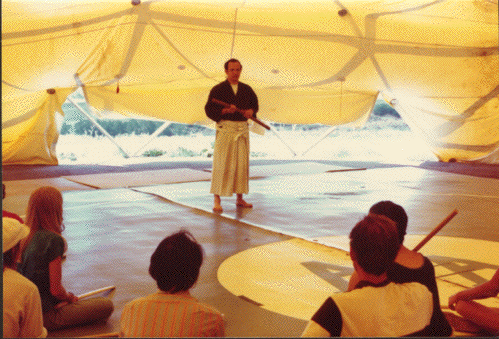
Aikijutsu class under the geodesic at Aspen Academy of
Martial Art, 1977. (Photo by the author.)
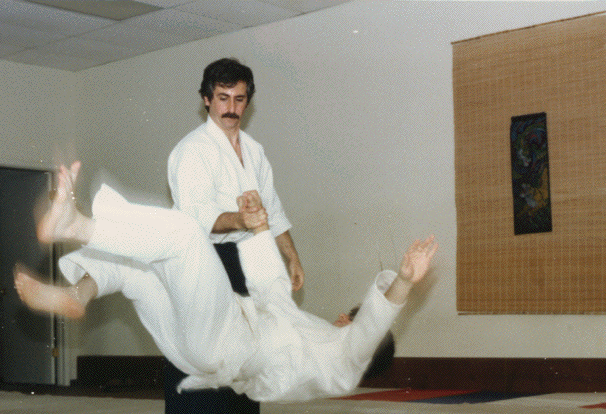
Yours truly performing jiujinage, around 1988. The
courageous uke is Dan Rabinovitsj. (Photo by Margaret
Schell.) Back to top.
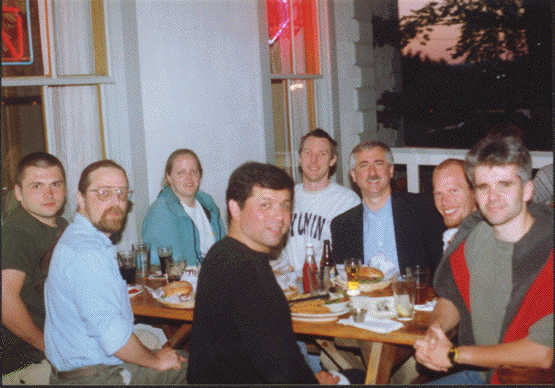
Several of Jinshinkan Dojo's faithful core (L to R): Sergey
Zaderey, Don Neuhengen, Andrea Pavlick, Robert Rios, Scott Prahl,
Fred Phillips, Alex Nelson, Alex Kotov. At the Cornelius Pass
Roadhouse, Hillsboro, Oregon, 1999.
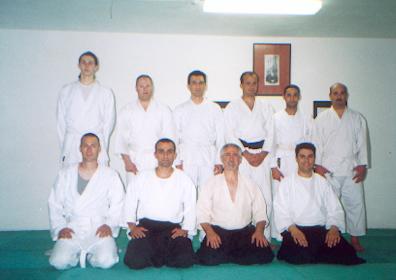
Teaching in Malta, 2005.
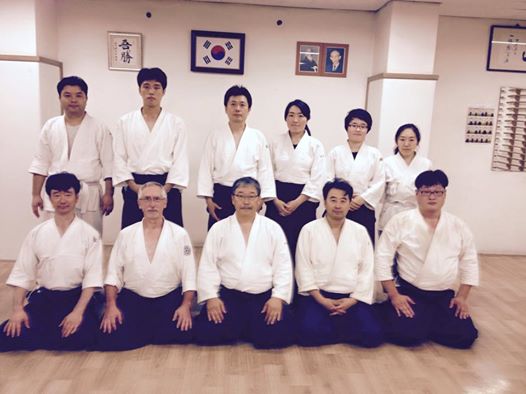
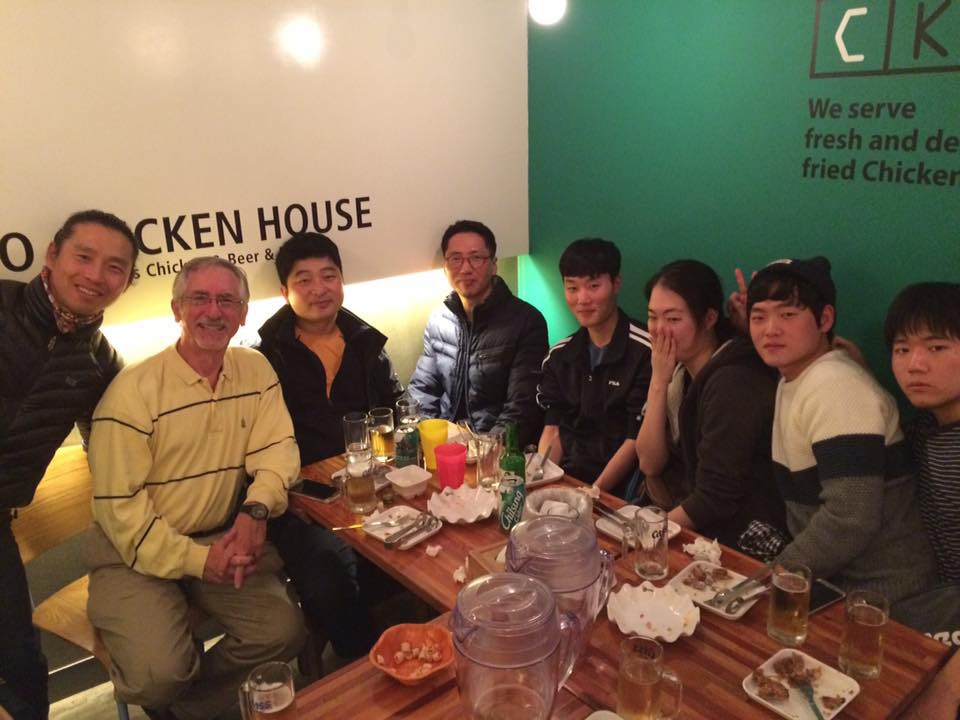
Left: Korean Aikido Federation HQ, Seoul, with Yun
Sensei, head of KAF.
Right: Members of the Incheon Dojo of the Korean Aikido
Federation. Dojo-cho Mr. Im, on my right.

Teaching in Indonesia, September 2016, near Tangerang. On
my left, dojo-cho Zainal Riffandi Anwari.
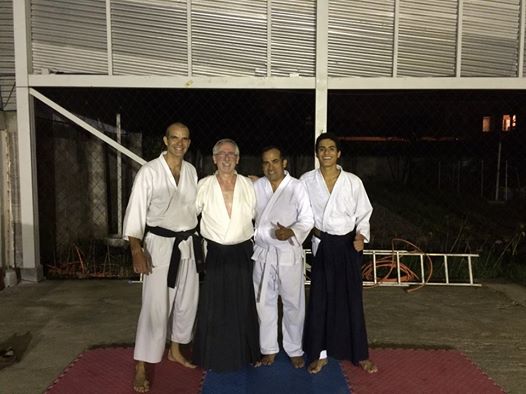

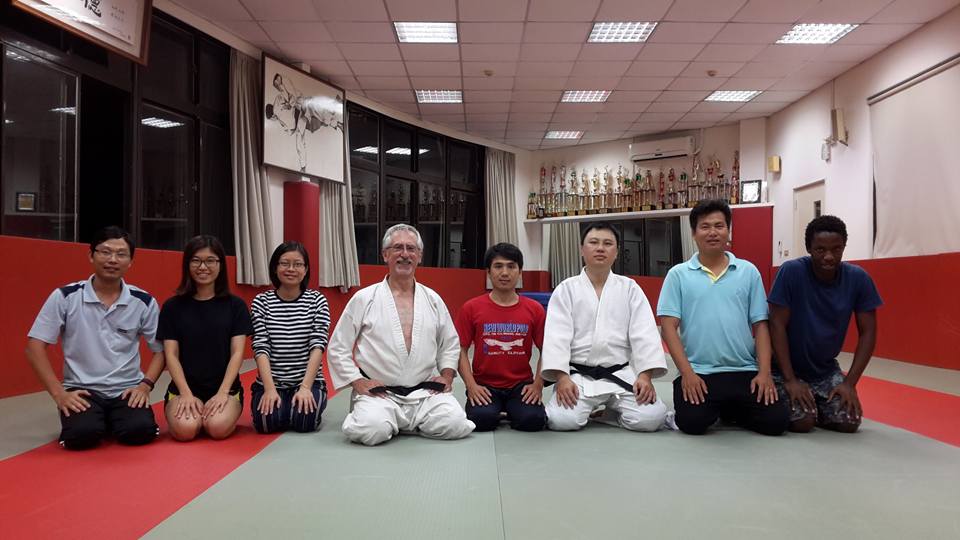
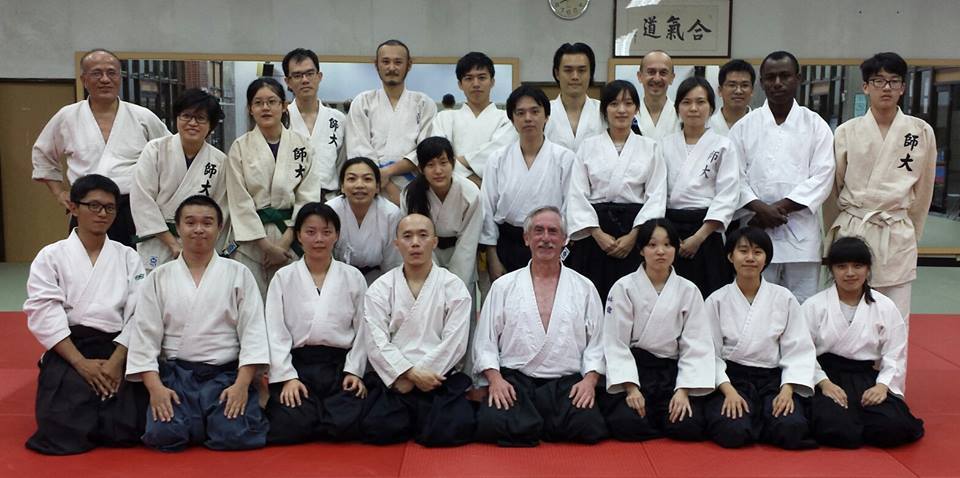
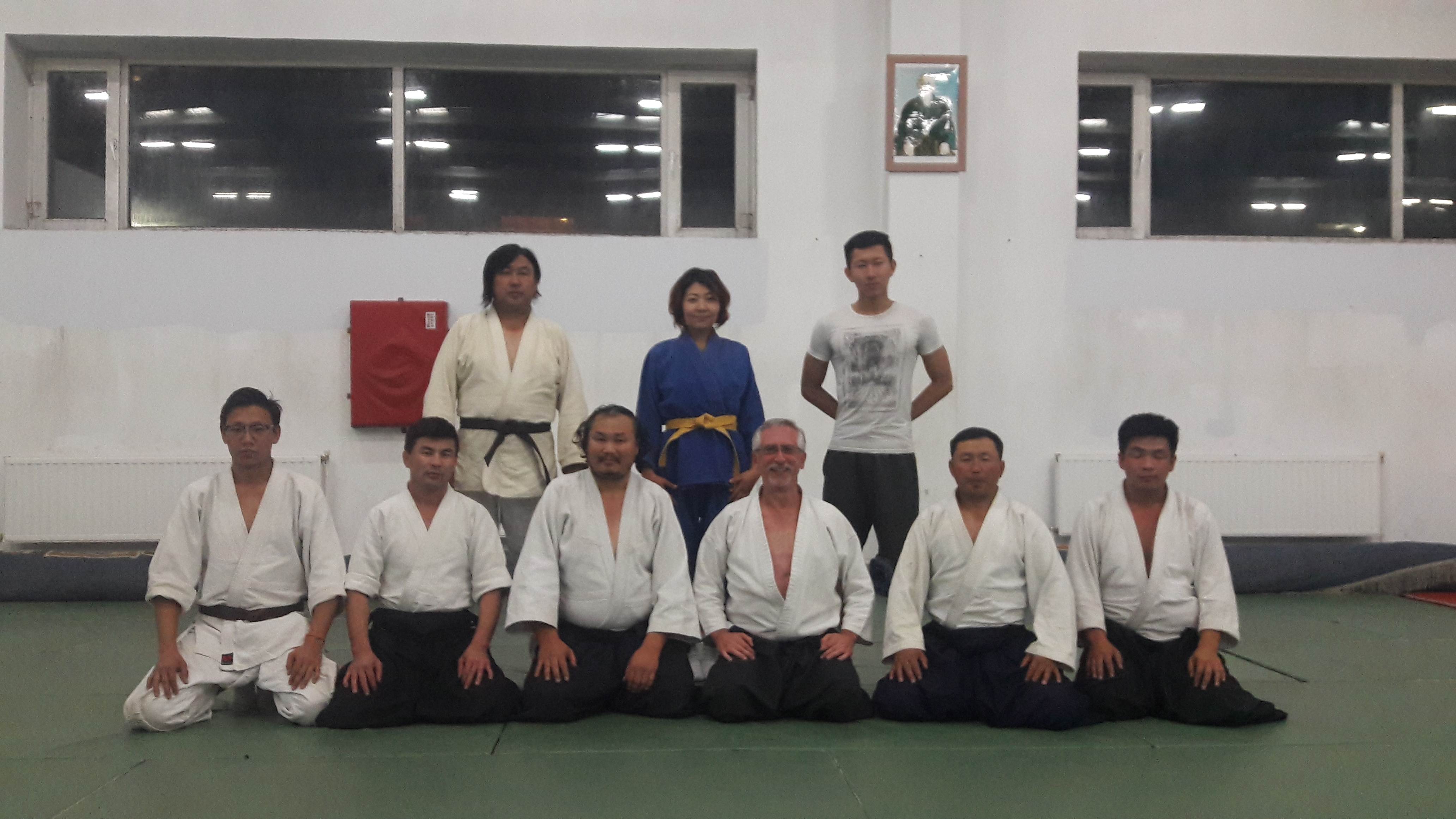
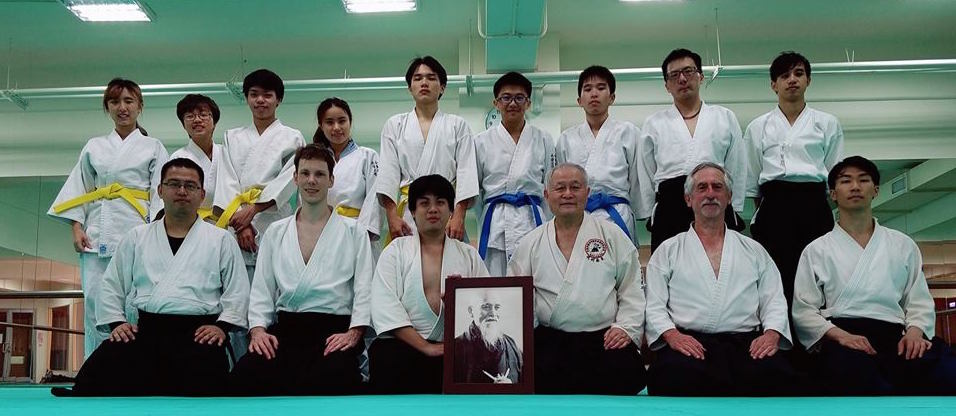
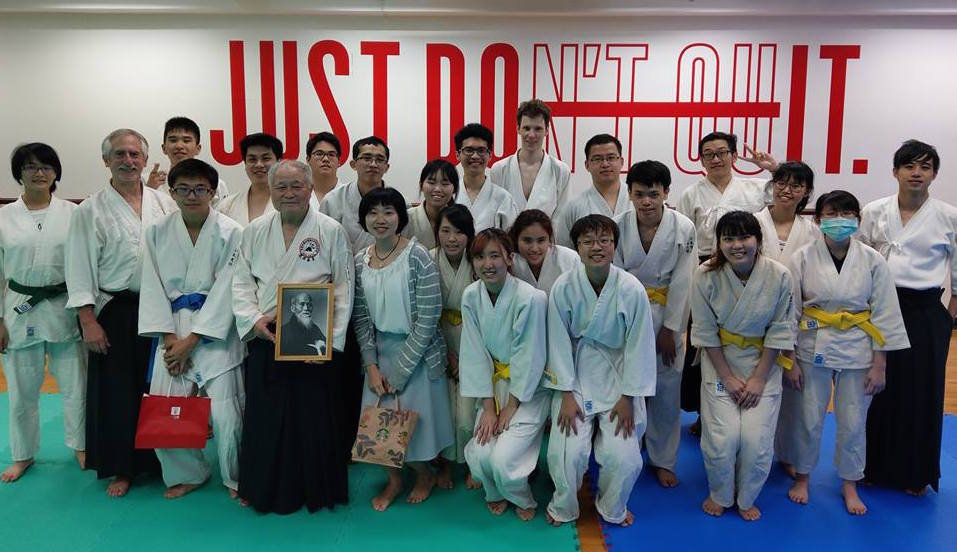
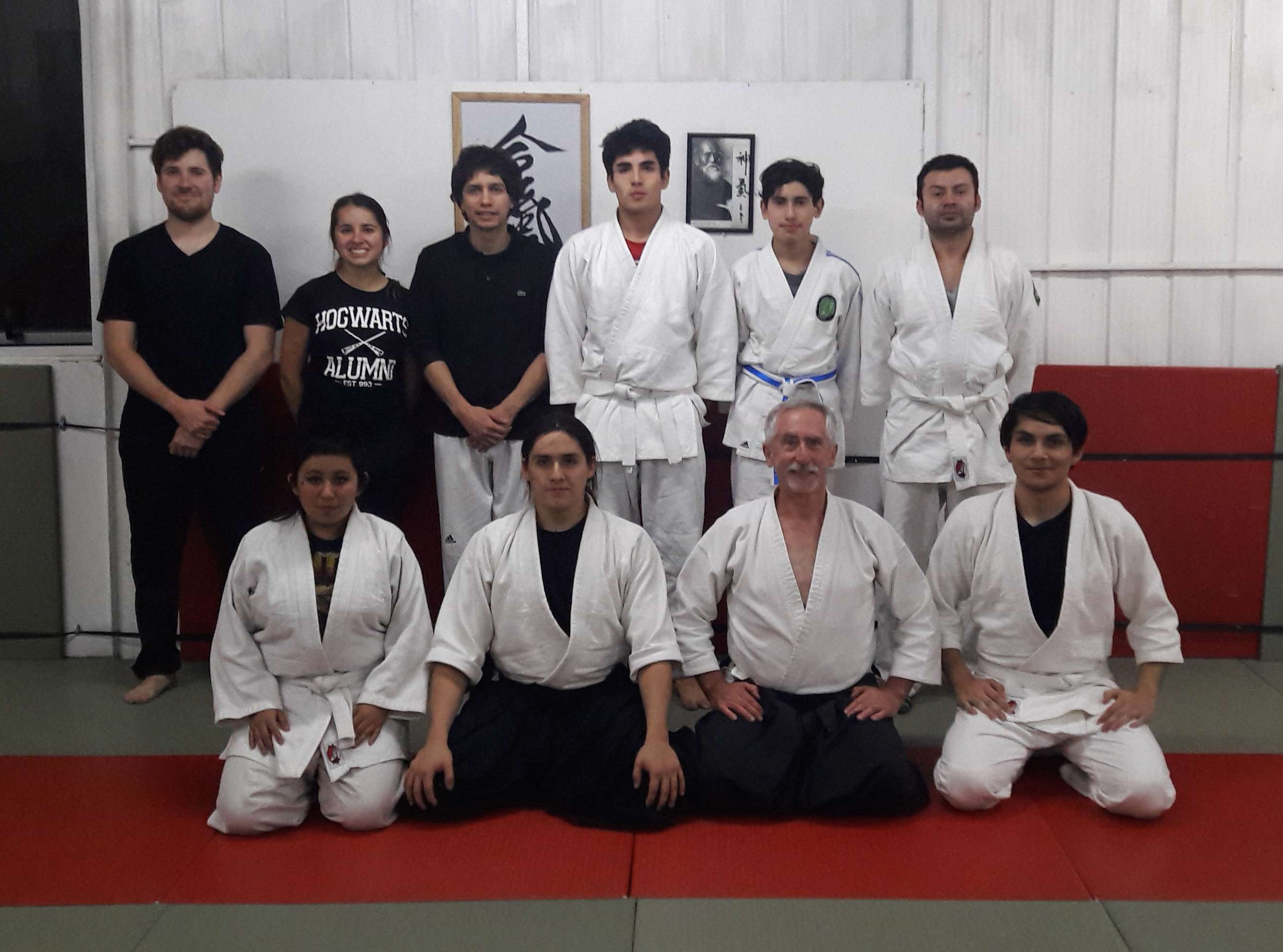

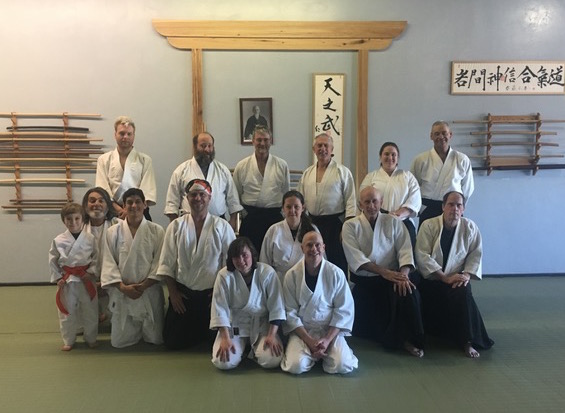
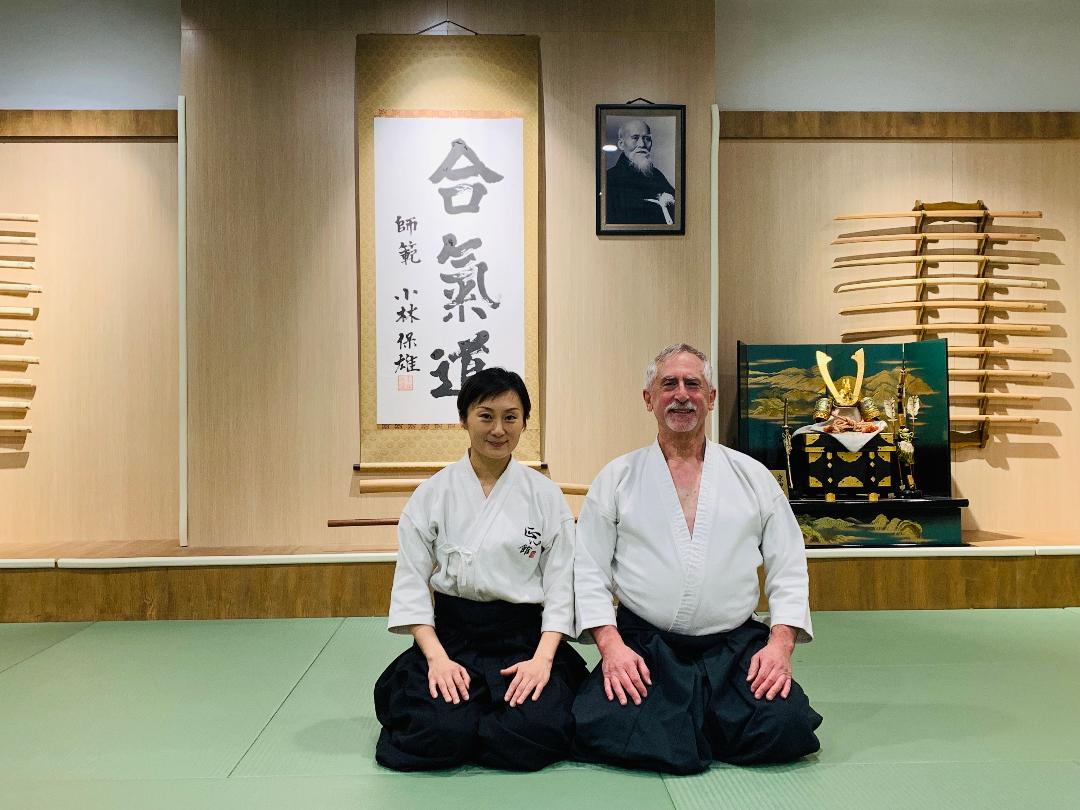


Before
our panel at Miles Kessler Sensei’s Aikido
at the Leading Edge Tele-Summit (May
15th, 2017 - Panel Discussion: “Old School vs. New School:
Learning Methods In Aikido” | Josh Gold, Charles Colten, Fred
Phillips, moderated by Paul Linden Sensei), Paul Linden sent
interview-type questions to the panelists. The actual panel
discussion took a direction different from those questions, so I
post my original answers here.
What
is your background?
I’m
American. I began my aikido training in Texas in 1973, after a
bone-breaking year in judo. My aikido teachers were Bill Lee,
Rod Kobayashi, Koichi Tohei (in Japan in the mid ‘70s), and
Fumio Toyoda. The latter two emphasized meditation and Zen as
integral to aikido. I’ve been a traveler since Toyoda’s death in
2001, living in 4 countries and visiting and teaching in dojos
in a couple dozen, in Europe, Asia, Latin America, and the
Middle East. I’ve seen a huge variety of practice styles and
technical emphases. Toyoda wanted his students to absorb diverse
inputs. I think I’ve followed his advice in spades.
What
is the old model of learning aikido?
The
teacher demonstrates. The students vigorously practice what they
think they saw the teacher doing.
What
are its drawbacks?
Students
practice technique incorrectly, and pass the errors on to their
students.
What
are its benefits?
Good
aerobic exercise. Trial-and-error learning, if ukes offer more
encouragement than correction for beginner nages, helpfully show
more advanced students where a wrong execution can be blocked,
and strive for vigorous realism with yudansha.
What
is the relation between teaching and learning in aikido?
Same
as for any subject: Teaching helps you learn. A teacher has to
decide what is important to convey, and codify it for
transmission. Dojo duty differs from academic subjects though,
in that it includes the sempai-kohai relationship; everyone is
responsible for teaching.
I
recall a small woman trying to execute kokyu nage on a very big
guy. She could not move him. After several tries, she reached up
on tiptoe and kissed his cheek. He was so unnerved, he fell
down. The student found a new way to lead the partner’s mind,
and I learned from the student that there are many creative ways
of leading.
What
new approaches have you seen being used?
Tohei
Sensei knew he couldn’t make short-term visitors to Japan into
expert aikidoists. He emphasized teaching visitors how to
conduct aikido classes, and how to re-create technique through
reference to his ki principles – what Paul Linden Sensei has
called “teaching algorithms, not technique.” Toyoda’s
organization is focused on developing high teaching standards.
Today a lot of aikido is being taught, but we still don’t see
much teaching how to teach. It is needed.
More
recently, YouTube is fantastically valuable. This week Mr.
Kessler is showing us the value of social media in teaching
aikido – or at least in talking about aikido! Teachers do talk
more these days, sometimes too much. In my early years, the only
words teachers said to me were, Try Again!
YouTube
of course is only visual learning, without feedback. New
Internet devices are appearing that allow fuller tactile and
proprioceptive interfaces. I’m sure these will be marketed first
as sex toys, but soon someone will figure out how to transmit a
good katate tori.
What
approach do you use? Can you briefly summarize?
First,
I like humor as a teaching tool. When people laugh, their
breathing improves, and the lesson is better retained. I have to
be careful in the various countries, when I’m “joking
seriously,” to avoid cultural gaffes and translation problems.
Also I limit it so that students who are worried about their
performance, or just taking themselves way too
seriously – as opposed to correctly taking the martial art
seriously – will not think I’m making fun of them.
Second,
I motivate students by getting them to experience something
outside their everyday reality. As a beginner I had read about
aikido’s unusual mind-body effects, and I’d found ideas like the
unbendable arm implausible. My earliest teacher, Jay Portnow,
never mentioned ki, but one day he made us do the shomen uchi
ikkyo exercise ad nauseum: 1, 2! 1, 2! 1! And he heaved on my
arm, and nothing
happened. My arm didn’t bend. It was a “Wow, man” moment.
Last year in Indonesia, students asked about “no-touch throws.”
They were skeptical. But because these throws are just a matter
of timing and posture, and no deep mysteries are involved, they
were all performing them well within 20 minutes.
I
most enjoy students who are open to being shaken out of their
preconceived reality.
Sometimes
motivation is just a matter of cutting in to a pair practice, to
move an uke who is stymying his nage by standing solidly, and to
move him without using effort, without conveying any tense or
fighting signals. When that student has been trying for ten
minutes to move his even bigger partner, that kind of teaching
makes a lasting impression.
How
do you convey it?
Listen,
I am in no way the world’s hottest aikidoist. Flashy
demonstrations are out of the question. But I am a very good
teacher, and I focus on diagnostics. Rather than just show right
and wrong ways of doing a technique, I see where each student’s
movement needs adjustment, and show them, go this way, not that
way. The next student needs something different.
What
are the benefits of the new approach?
It
must be working. When I move on to a new job in a new country,
my students have actually got angry with me for leaving.
What
areas do you focus on?
That
aikido is martial art. Spiritual development comes from dealing
with the prospect of your own eventual death, a prospect that
logically can’t be separated from the idea of martial art.
That
meditation, whether Zazen or some other form of it, helps you
with that philosophical question, helps you understand your body
and your mind, and increases your flexibility in meeting the
unexpected, on the mat or off of it.
In
my day job I’m a management professor. Fifteen years ago I wrote
a book bringing my two lives together. It’s called The Conscious Manager: Zen
for Decision Makers. Miles has given copies to some of
you. Readers find it “difficult but rewarding,” ha ha. Though
it’s only peripherally about aikido, it is in the spirit of
Tohei Sensei’s “Aikido in Daily Life.”
What
areas do you not attend to?
Here
I should say that a beginning teacher’s most common error, aside
from talking too much, is showing too many wrong ways to do a
technique. By the time a teacher has shown the class six “most
common errors in this technique,” the class has forgotten the
right way to do it! I emphasize this for beginning teachers.
Students know that demonstrating wrong ways is easier than
showing the right way. You will lose credibility if you do it
too much.
Let
the students make the mistakes on their own – even if it’s the
same mistake many generations of students have made before. Body
learning is more powerful than visual learning.
I
don’t see any Japanese instructors in this tele-summit! I
believe most of them would be horrified that we’re here talking
talking talking.
Is it
different for different individuals?
Absolutely.
There are four or five ways to successfully execute each
technique, but hundreds of reasons for students to believe they
cannot do it. The
reasons come from all the “domains” Paul has listed
(intellectual, physical, emotional, social, international,
ecological, and spiritual). “I’m not strong enough.” “I’m too
tense.” Or all too often, “I’m just a girl.” Yes really, we’re
still hearing that last one, at least in Asia, in 2017!
Obviously
not all these reasons are easily visible. The teacher must
discern what is bothering each student, and suggest how the
student may work it out.
My
absolutely most memorable experience as a teacher involved a
Vietnam veteran who had been a tunnel rat during the war there.
Now, this was the scariest possible duty; underground, you could
never know what weapon or booby trap would await you around the
next corner. Before the seminar, his teacher warned me that this
fellow had been a continuous nervous wreck through all the 15
years following the end of the war. He was muscling and
twitching his way through a technique. I showed him how to
effect the technique with no effort. The look that came over his
face showed his epiphany. It said, “I don’t have to struggle
after all.” He started crying. He sat on a bench for a while,
then rejoined the class, with a completely different body
posture.
Who
is your intended audience?
Anyone
who sincerely wants to learn.
Do
the tools you teach work across cultures?
They
need customization. Koreans tend not to stand close enough to
their attackers following the initial tai sabaki. This is
because the customary interpersonal distance in Korea is farther
than, for example, in the USA. In Korean aikido and tango
classes, we have to insert a “hugging practice” module. This
kind of thing is no problem, on the other hand, in for example,
Egypt, where very close conversational distance is the norm.
O-Sensei
called aikido a universal art. Toyoda Sensei thought aikido was
inseparable from Japanese culture. We could have a very
interesting chat about that. Tohei Sensei complained that his
Japanese students trained hard physically without thinking about
aikido, and his American students thought about it, said “I got
it,” and then didn’t want to train. He joked that maybe Hawaiian
students would show the right balance.
Do
they give everyone much the same results?
In
the kyu ranks, yes, because we want standard performances on
promotion tests. For dan ranks, we want to see technique infused
with the student’s personality. We want to see they’ve made the
art of aikido their own while they’ve developed technical skill.
I
am okay with today’s talking talking talking, because though
we’re all traveling the same path, we all find our own
obstacles, and frequently find ourselves on what George Leonard
Sensei called plateaus of learning. That is, we advance not with
smooth continuity, but in fits and starts. We need to hear the
same truth repeated using different voices and vocabularies –
the vocabularies of the faculty of this tele-summit – to get us
off the current plateau and on to the next.